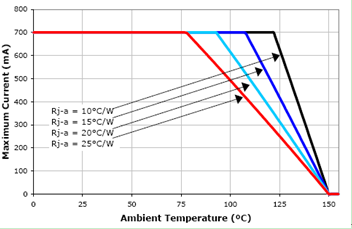In the foregoing, we have already mentioned that high temperatures will cause permanent damage to the LED and shorten its life. The temperature increase will reduce the luminous efficiency of the LED.
4.Influence of temperature on the wavelength (light color) of automotive led bulbs light
The emission wavelength of an LED can generally be divided into a peak wavelength and a dominant wavelength. The peak wavelength is the wavelength with the greatest light intensity, and the dominant wavelength can be determined by the X, Y color coordinates, reflecting the color perceived by the human eye. Obviously, the change of the LED light-emitting wavelength caused by the junction temperature will directly cause the human eye to feel differently about the LED light color. For an LED device, the band gap value of the light emitting region material directly determines the wavelength or color of the light emitted by the device. As the temperature rises, the bandgap of the material will decrease, resulting in longer device emission wavelengths and red-shifted colors.
The variation of wavelength with junction temperature can usually be expressed as the following formula: form (2)

Amontg this, means the wavelength (nm) when the junction temperature
means the wavelength (nm) when the junction temperature  is indicated,
is indicated, menas the wavelength(nm) when the junction temperature
menas the wavelength(nm) when the junction temperature  ,
, means the the coefficient representing the variation of the wavelength with temperature, generally between 0.1 and 0.3 nm/K.
means the the coefficient representing the variation of the wavelength with temperature, generally between 0.1 and 0.3 nm/K. .
.
5)Temperature Effect on LED Forward Voltage
The forward voltage is an important parameter to determine the performance of the LED, and its size depends on the characteristics of the semiconductor material, the size of the chip, and the process of forming the junction and electrode of the device. Relative to the forward current of 20mA, the forward voltage of the InGaAlP LED is usually between 1.8V and 2.2V, and the forward voltage of the InGaN LED is between 3.0V and 3.5V. With a small current approximation, the forward voltage drop of an LED device can be expressed by form (3):
 (3)
(3)
in the form,the  is Forward Voltage,
is Forward Voltage, is forward current,
is forward current, is opposite saturation current,
is opposite saturation current, is Electronic charge,
is Electronic charge, is Boltzmann constant,
is Boltzmann constant, is Series resistance,
is Series resistance, is a parameter that characterizes the perfection of a P/N junction and is between 1 and 2,On the right side of formula (3), only the opposite saturation current
is a parameter that characterizes the perfection of a P/N junction and is between 1 and 2,On the right side of formula (3), only the opposite saturation current  is closely related to temperature.The value of
is closely related to temperature.The value of  increases as the junction temperature increases,that Causes a decrease in forward voltage value of
increases as the junction temperature increases,that Causes a decrease in forward voltage value of  Experiments indicate that for a certain LED device, the relationship between the forward voltage drop at both ends and the temperature can be expressed by Equation (4) when the input current is constant:
Experiments indicate that for a certain LED device, the relationship between the forward voltage drop at both ends and the temperature can be expressed by Equation (4) when the input current is constant:

in this form, and
and  is positive pressure drop when it is Junction temperature of
is positive pressure drop when it is Junction temperature of  and
and  .
. is coefficient of pressure drop with temperature,usually between -1.5~-2.5mV/K,
is coefficient of pressure drop with temperature,usually between -1.5~-2.5mV/K, .
.
When the current is fixed, the temperature rises and the LED forward voltage drops. Because the relationship between forward voltage and temperature is nearly linear, most LED thermal resistance testers use this characteristic of LEDs to measure their thermal resistance or junction temperature.
6.Excessive temperature limits the LED's maximum injection current
As the temperature increases, the bandgap of the material will decrease, resulting in a decrease in the maximum injection current.

Cree 3WXLampXP-E Maximum Injection Current vs. Junction Temperature
In addition, the temperature will also affect the LED light distribution curve, color temperature and color rendering.
The temperature affects the refractive index of the light-transmissive material, which changes the spatial distribution of the light emitted by the LED, that is, the light distribution curve.
If the temperature is too high, the peak of the blue light shifts, and the peak of the phosphor becomes flat and deteriorates, which leads to a high color temperature of the LED and poor color rendering.
(7).Conclusion:
High-power LEDs, due to their large heat output, cause high operating temperatures and drastically degraded performance. Only in-depth understanding of the LED temperature characteristics, the development of low thermal resistance LED chips and LED applications, in order to truly reflect the advantages of LED.